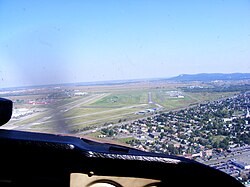MET – Montreal Metropolitan Airport
Airport in the Saint-Hubert borough of Longueuil, Quebec, Canada From Wikipedia, the free encyclopedia
Airport in the Saint-Hubert borough of Longueuil, Quebec, Canada From Wikipedia, the free encyclopedia
MET – Montreal Metropolitan Airport (IATA: YHU, ICAO: CYHU) (French: MET – Aéroport métropolitain de Montréal),[4] formerly known as Montréal Saint-Hubert - Longueuil Airport (Aéroport Montréal Saint-Hubert - Longueuil) or Montréal/Saint-Hubert Airport, and still commonly referred to as St-Hubert airport, is located in the Saint-Hubert borough of Longueuil, Quebec. The airport is located 16 km (9.9 mi) east of Downtown Montreal and 3 nautical miles (5.6 km; 3.5 mi) east of downtown Longueuil.[1]
MET – Montreal Metropolitan Airport MET – Aéroport métropolitain de Montréal | |||||||||||||||||||
|---|---|---|---|---|---|---|---|---|---|---|---|---|---|---|---|---|---|---|---|
 | |||||||||||||||||||
| Summary | |||||||||||||||||||
| Airport type | Public | ||||||||||||||||||
| Operator | DASH-L (Développement Aéroport Saint-Hubert de Longueuil) | ||||||||||||||||||
| Serves | Greater Montreal | ||||||||||||||||||
| Location | Longueuil, Quebec | ||||||||||||||||||
| Built | 1927 | ||||||||||||||||||
| Time zone | EST (UTC−05:00) | ||||||||||||||||||
| • Summer (DST) | EDT (UTC−04:00) | ||||||||||||||||||
| Elevation AMSL | 90 ft / 27 m | ||||||||||||||||||
| Coordinates | 45°31′05″N 073°25′01″W | ||||||||||||||||||
| Website | www | ||||||||||||||||||
| Map | |||||||||||||||||||
 | |||||||||||||||||||
| Runways | |||||||||||||||||||
| |||||||||||||||||||
| Statistics (2023) | |||||||||||||||||||
| |||||||||||||||||||
As of 2023, it is ranked as Canada's 12th busiest airport by aircraft movements.[3] This airport mainly serves travelers to Quebec destinations.
The airport is classified as an airport of entry by Nav Canada and is staffed by the Canada Border Services Agency (CBSA) on a call-out basis from Montréal–Mirabel International Airport. CBSA officers at this airport can handle general aviation aircraft only, with no more than 15 passengers.[1]
Canada became involved in the Imperial Airship Scheme during the 1926 Imperial Conference, when Prime Minister William Lyon Mackenzie King pledged Canada’s assistance to Great Britain. Money was set aside for the construction of an airship base, airport and mooring mast in eastern Canada. British experts came over in May 1927 to choose a site; they visited a number of locations in Ontario, Quebec and Atlantic Canada, finally settling on a piece of land on the south shore of Montreal, at Saint-Hubert, and officially announcing this decision in August 1927. Work on the airfield began almost immediately and Saint-Hubert’s first airmail delivery took place in November 1927.[5]
It was also during the summer of 1927 that the Air Ministry decided to send the R100 to Canada. On August 1, 1930, the R100 airship arrived after what was possibly the first non-stop passenger-carrying powered flight across the North Atlantic to land in Canada.[5]
In the late 1930s the airport was used by Canadian Associated Aircraft to build the Handley Page Hampden.
Canada’s first air traffic control tower opened at the Saint-Hubert Airport on April 13, 1939.[6] It was Montreal's first and only airport until the opening of Dorval Airport (now Montréal–Trudeau International Airport) in 1941.

The airport was divided into two sides, a military side along with the Pratt & Whitney Canada facility (facing runway 06L/24R) and a civilian side (facing runway 06R/24L). Today the military base, the former RCAF Station St Hubert, has ceased operations, but the Armed Forces still use the base as a garrison comprising the tactical helicopter unit, 438 Squadron, 34 Service Battalion and 34 Canadian Brigade Group Headquarters. The ex-Pratt & Whitney hangar is owned and operated since 2012 as the largest FBO on the airport by an AvJet branded dealer: CYHU H-18 Services Inc. Their hangar is the newest addition to the FBO network: HUB FBO.
Following the new National Airports Policy announced by Transport Canada in 1994, ownership of the airport was transferred to a private corporation, Développement de l'aéroport Saint-Hubert de Longueuil (DASH-L), on September 1, 2004.
It was here that the body of Quebec Minister of Labour and Deputy Premier, Pierre Laporte, was found during the October Crisis of 1970.
In 2018, the runway was upgraded to accommodate larger aircraft and attract low cost carriers.[7] It was announced on February 27, 2023 that Porter Airlines will develop a new passenger terminal at the airport that is due to be completed in late 2024 and provide domestic flights throughout Canada.[8]
In 2024, it was unveiled that Saint-Hubert Airport would be rebranded to the Metropolitan Airport of Montreal (Aéroport métropolitain de Montréal) and use the abbreviation "MET".[9]
| Airlines | Destinations |
|---|---|
| Chrono Aviation | Iqaluit[10] |
| Pascan Aviation | Bagotville, Bonaventure, Îles-de-la-Madeleine, Mont-Joli, Quebec City, Sept-Îles, Wabush |
Seamless Wikipedia browsing. On steroids.
Every time you click a link to Wikipedia, Wiktionary or Wikiquote in your browser's search results, it will show the modern Wikiwand interface.
Wikiwand extension is a five stars, simple, with minimum permission required to keep your browsing private, safe and transparent.